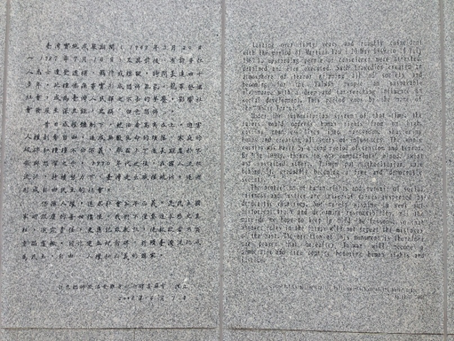First memorial established carrying the name “White Terror”
This memorial to the victims of the White Terror was set up in 2008 at the intersection of Ketagalan Boulevard and Huaining Street in Zhongzheng District, Taipei. It stands at the northwest corner of Jieshou Park.
This is the only White Terror memorial commissioned by Taiwan’s central government and set up on a national commemorative site. For a long time, the government had used the uncritical “martial law” instead of “White Terror” to avoid talking about the political persecution carried out by those in power during this period; therefore, the name of this memorial has great significance. The far end of the memorial faces the Presidential Office Building, a symbol of the nation’s highest authority. This is a reminder that the powers of the state should always be checked and balanced by democracy and human rights.

▲ The Winding Walkway of Remembrance next to the Memorial to the Victims of the White Terror. (Source: National Human Rights Museum)
A witness to both the tragedy of history and the hope of conciliation
Planned by the Ministry of the Interior and designed by architect Wang Lifu, the memorial consists of a 20.7-meter-high monument, a memorial wall, a pond, a terrace and the Winding Walkway of Remembrance, collectively forming a memorial plaza. Cracks and fissures are a prominent design feature of the memorial plaza. For instance, the platform above the round pond has been broken up into pieces. Irregular cracks and fissures are also found on the curving memorial wall. These symbolize the broken lives of the victims and the bitter history of Taiwan. The pond reflects the monument, a symbol of justice. At the same time, the all-encompassing nature of water is also a symbol for reconciliation among different peoples.
There are both Chinese and English inscriptions on the monument, written by members of the memorial committee. The English message was penned by Lynn Miles, who worked tirelessly on human rights rescue efforts in Taiwan during the White Terror. His message imparts that “memory, comfort, harmony and unity” were the main goals for establishing the memorial. The end of Miles’s message reads: “The protection of human rights and the pursuit of social fairness and justice are universal values respected by democratic countries. Not merely wishing to seek out historical truth and determine responsibility, all the more do we hope to keep in mind the lessons so that whoever rules in the future will not repeat the mistakes of the past. The erection of this monument is, therefore, our prayer that hereafter Taiwan will become a democratic and free country honoring human rights and justice.” The memorial is an important milestone of Taiwan’s pursuit of transitional justice.

▲ Inscription on the Memorial to the Victims of the White Terror. (Source: National Human Rights Museum)








